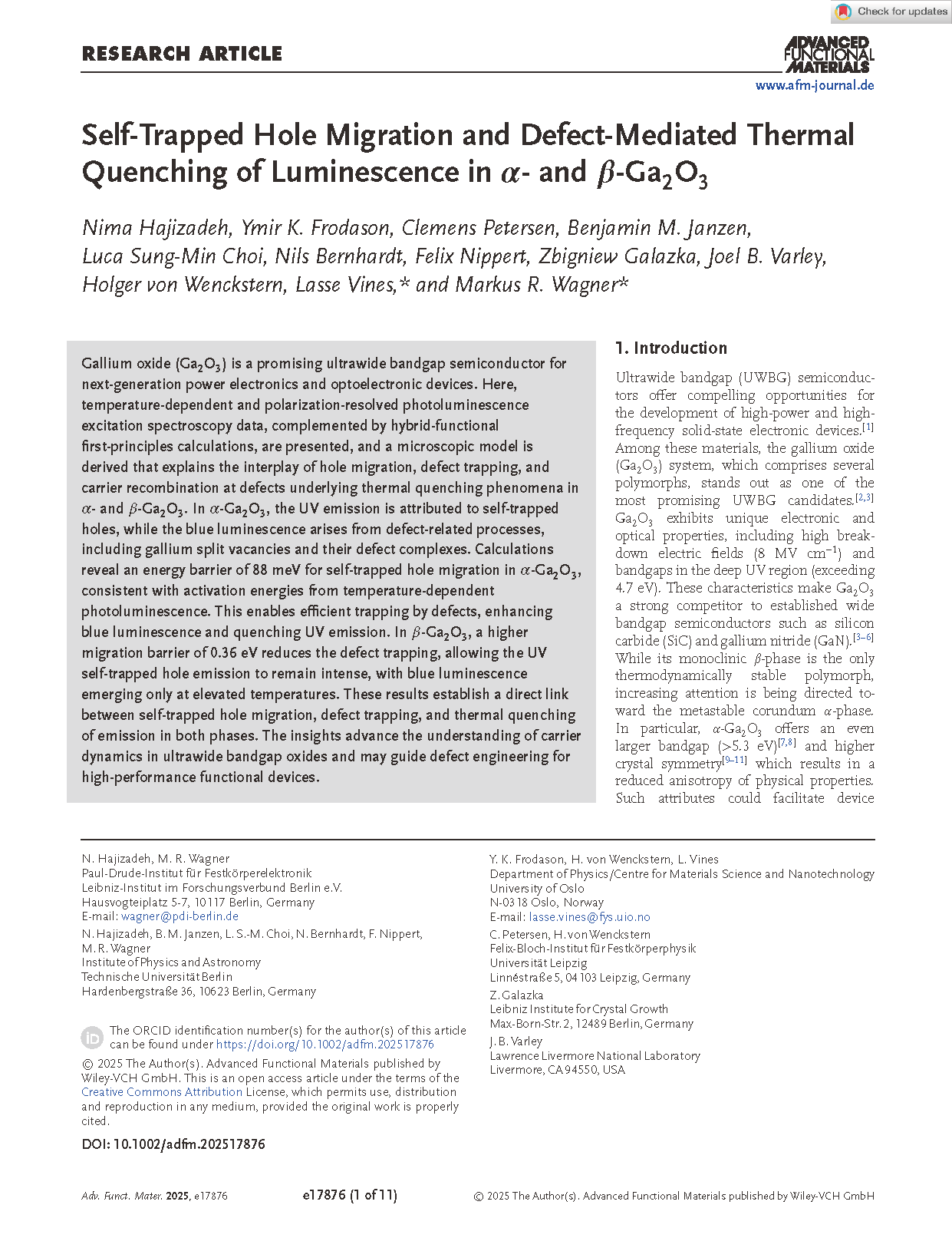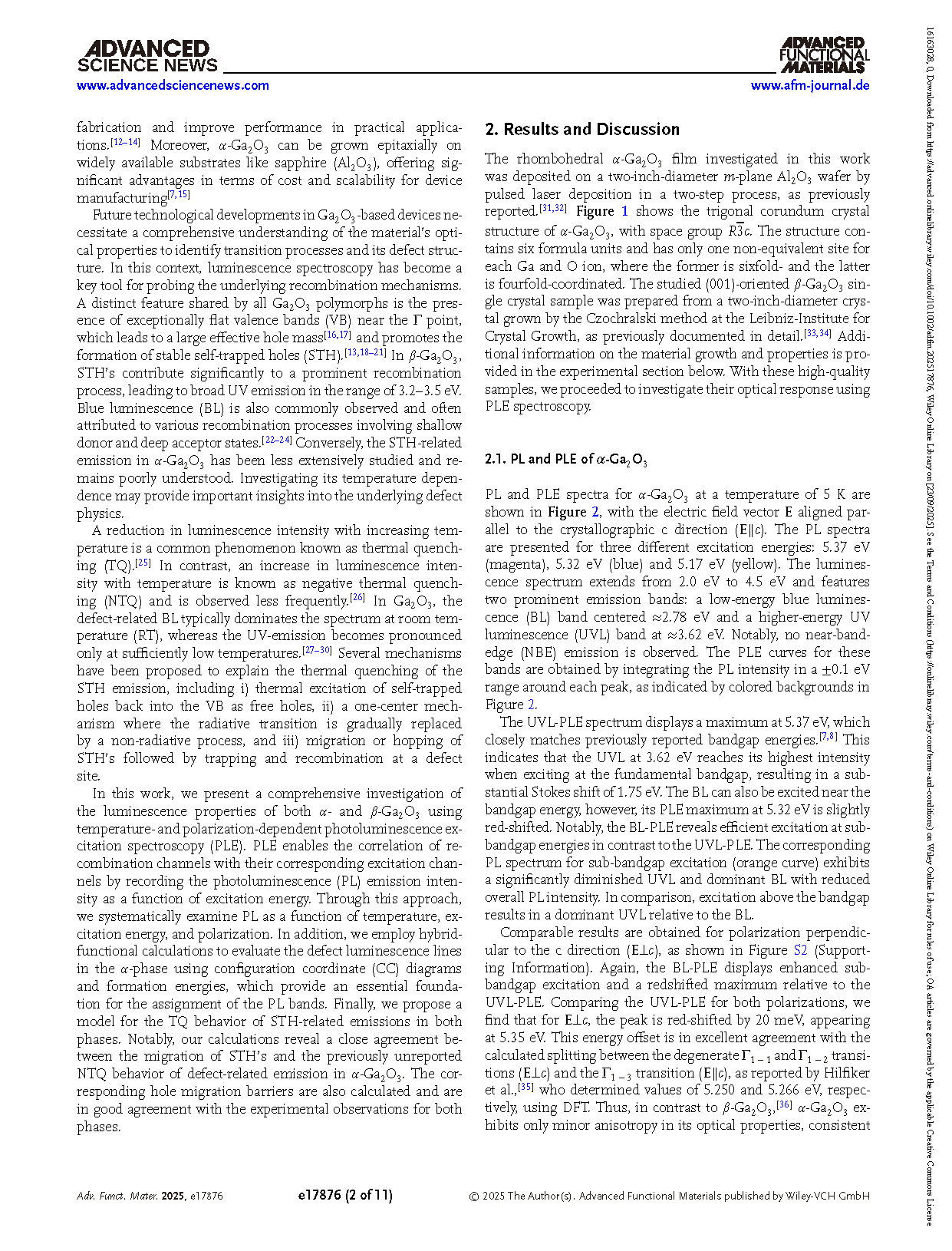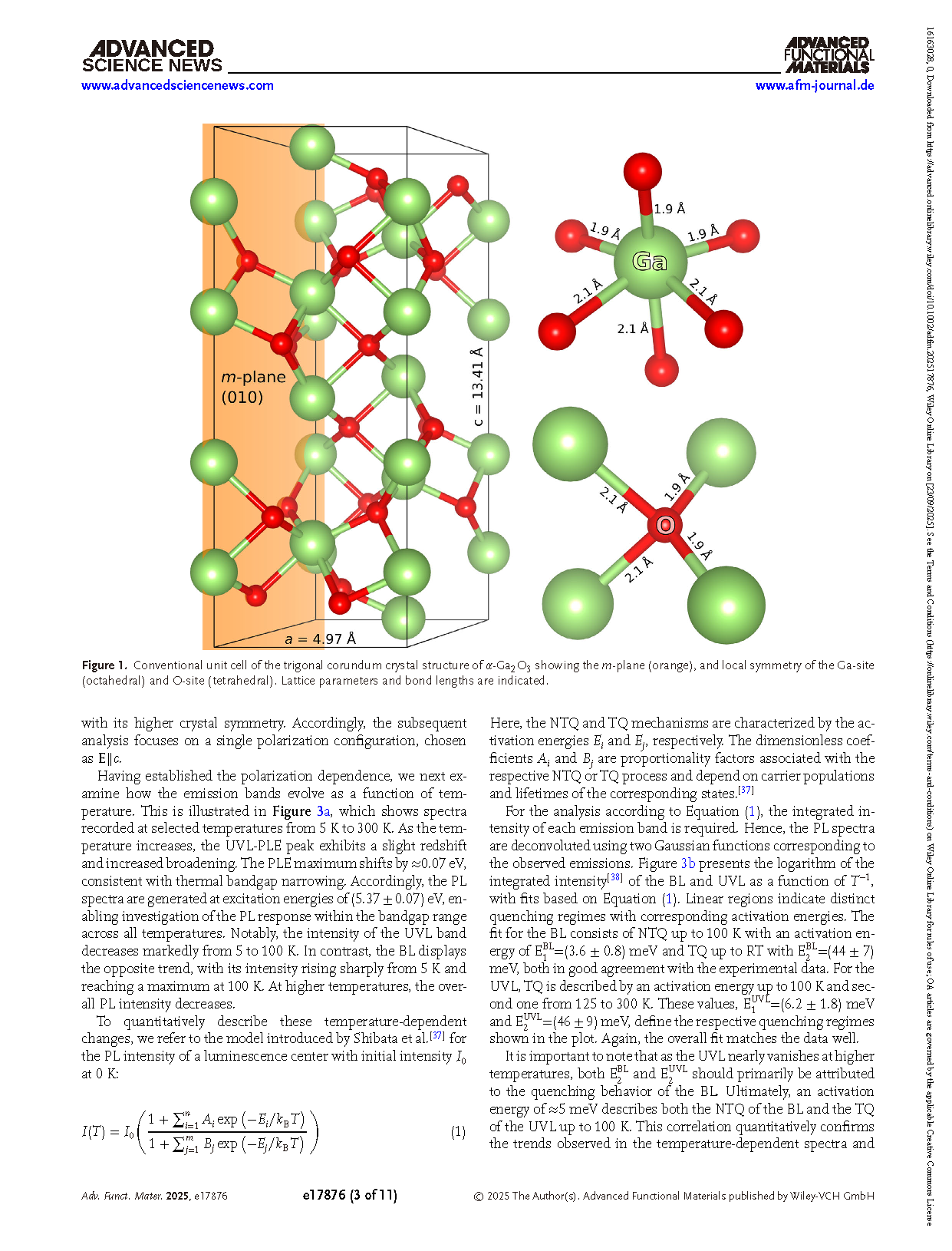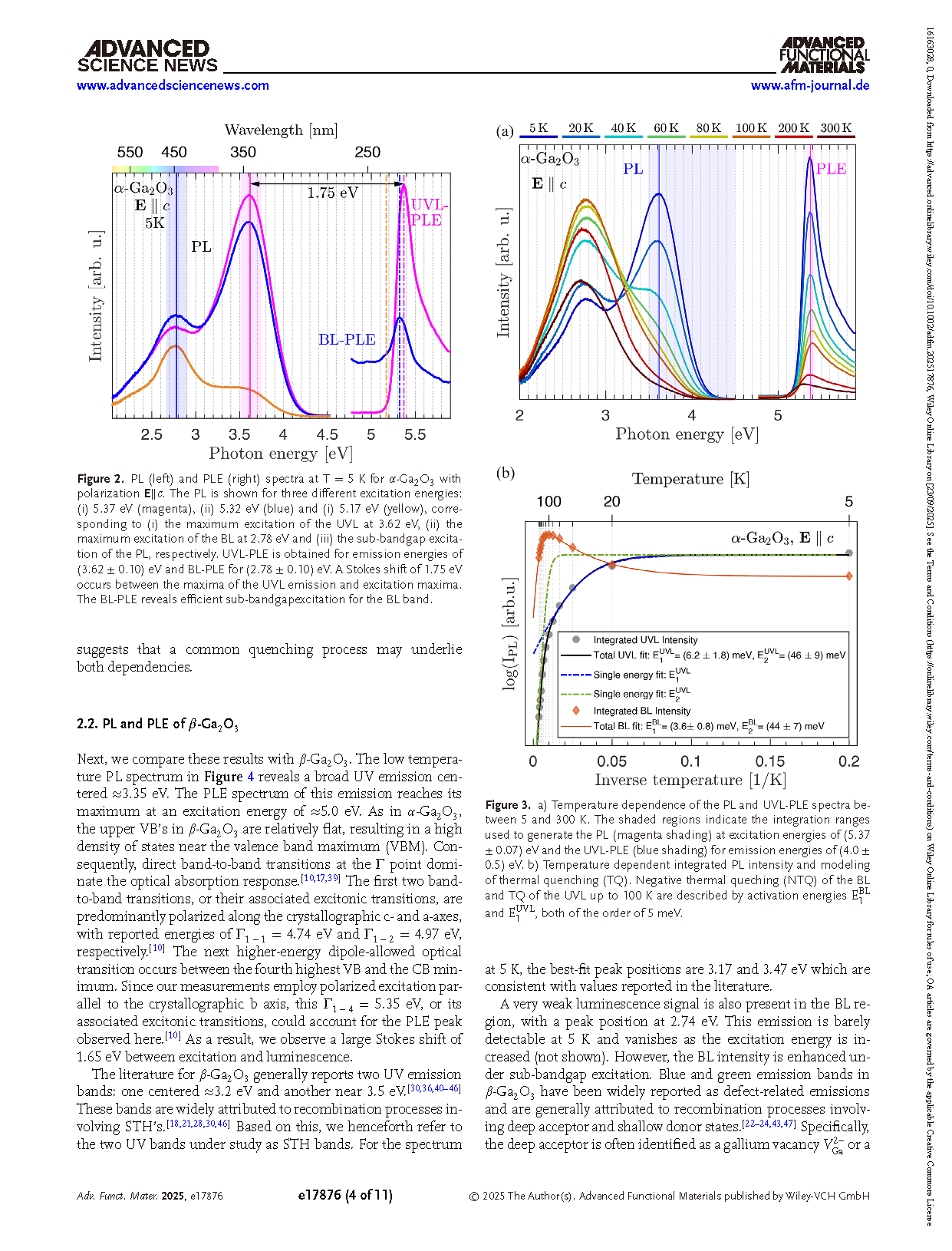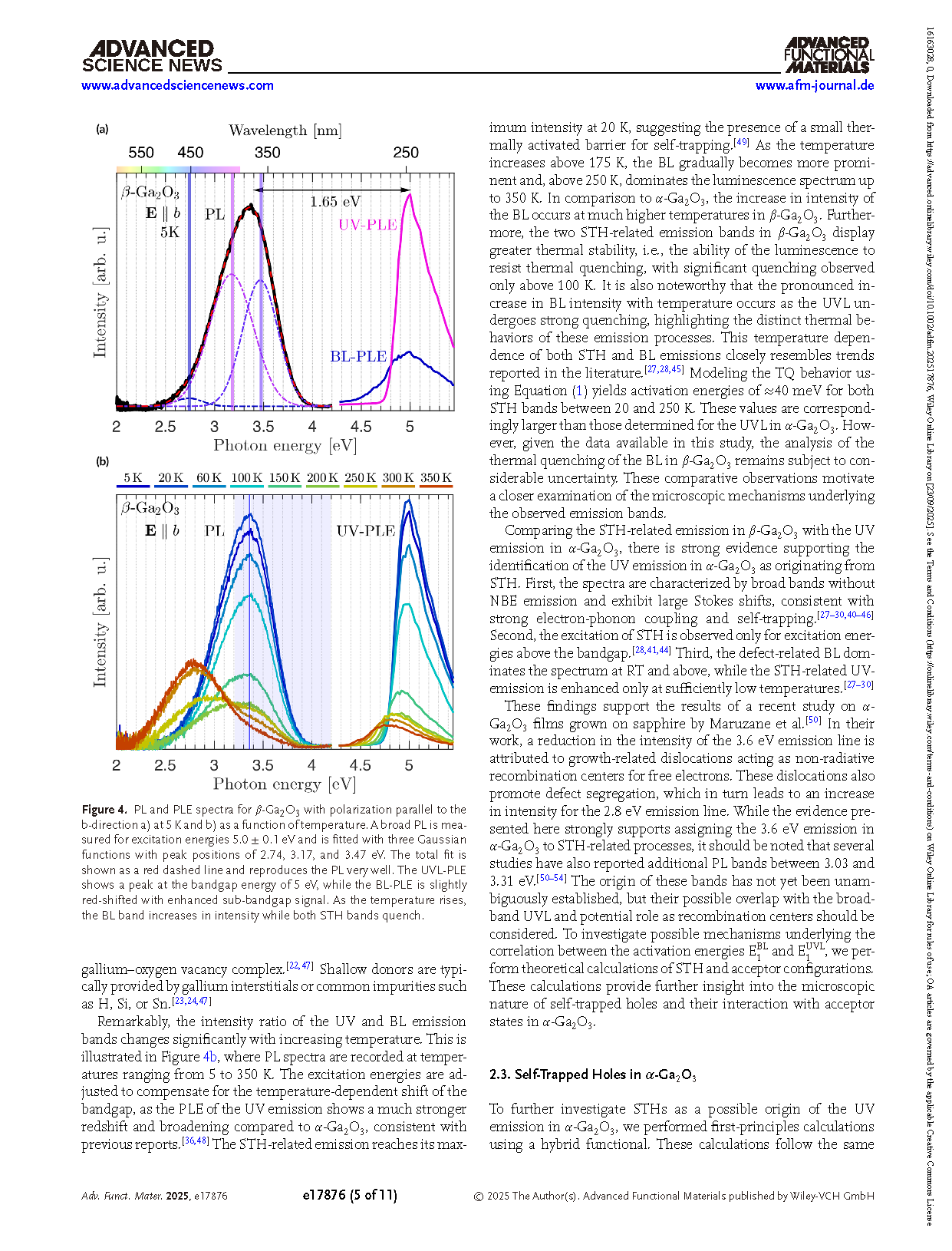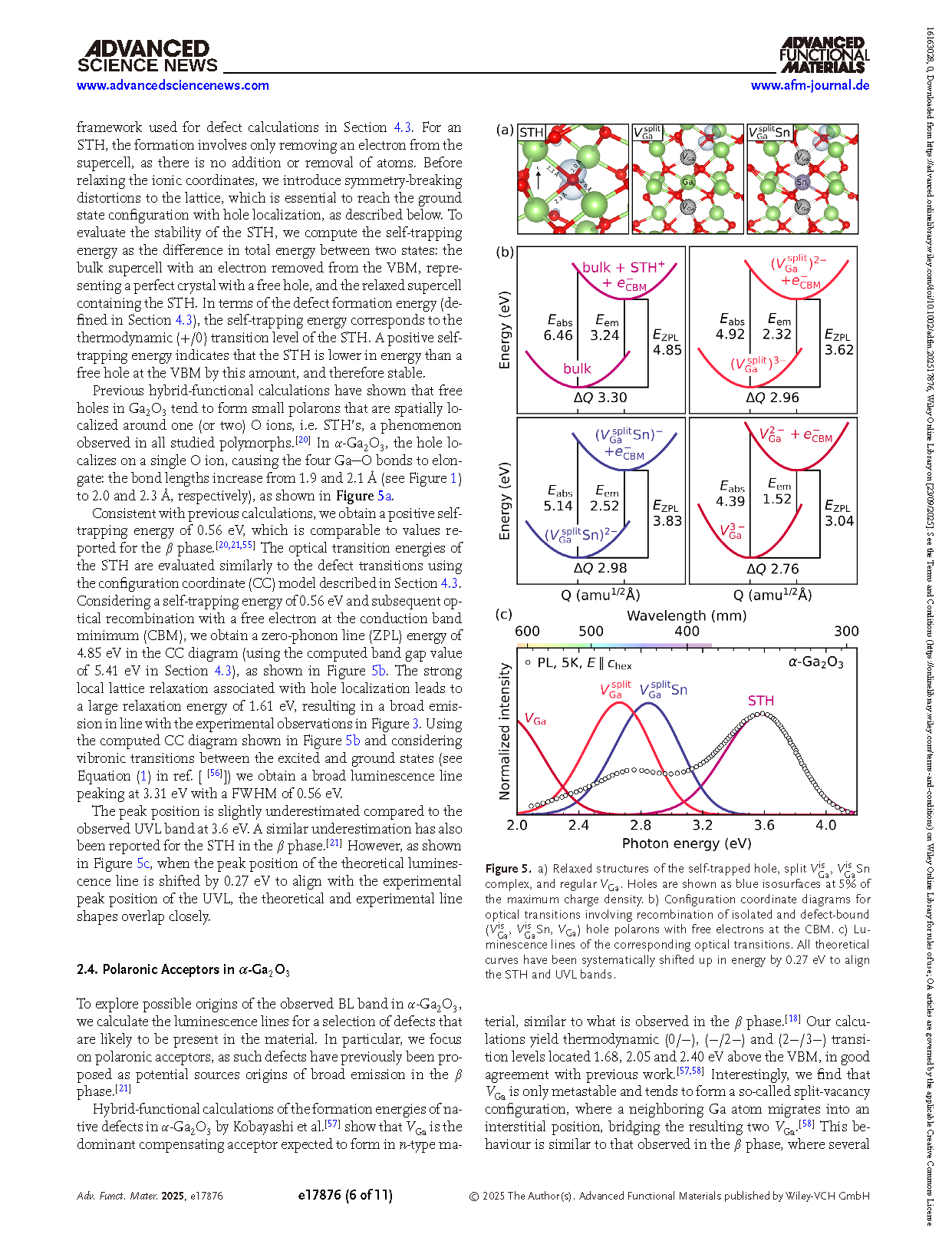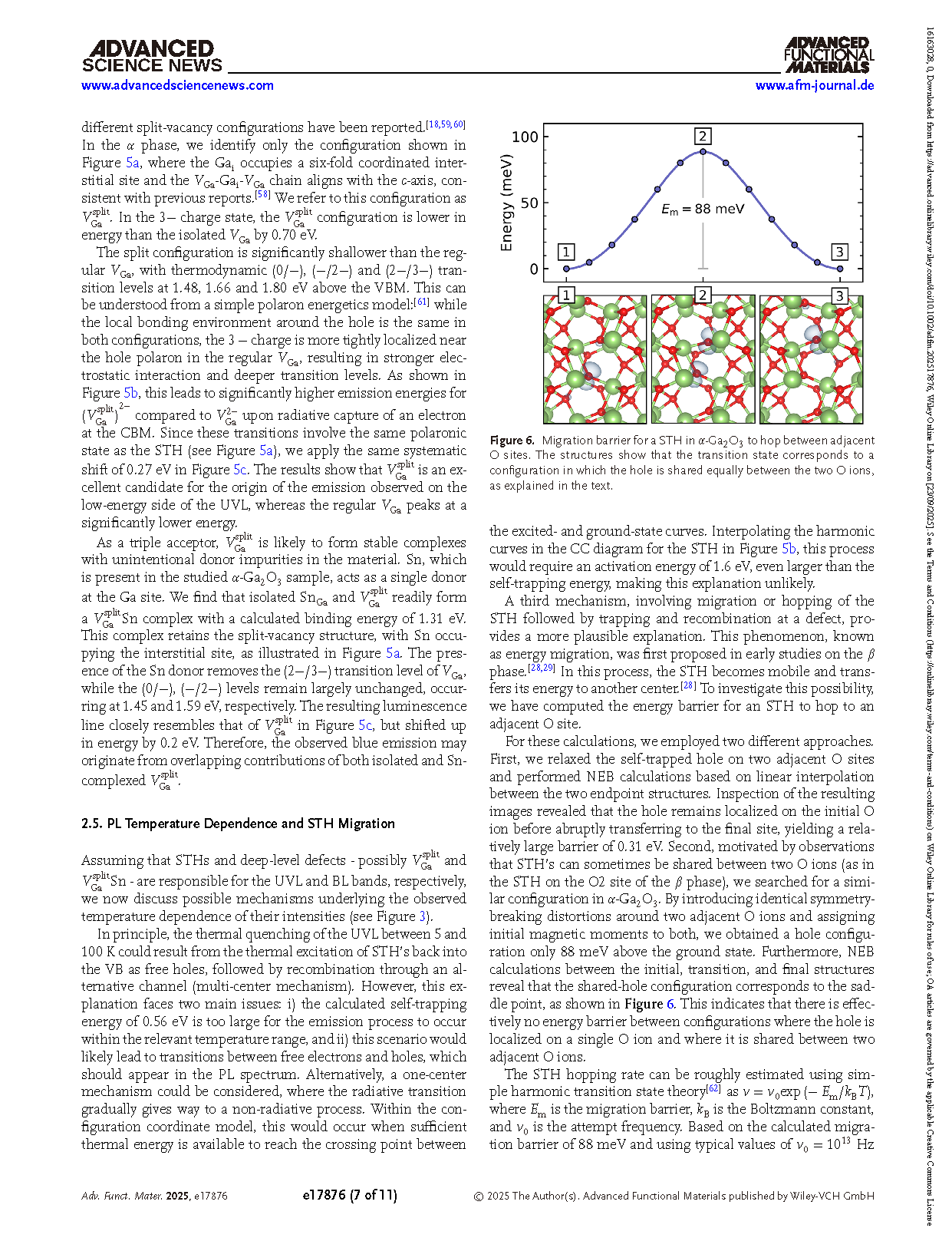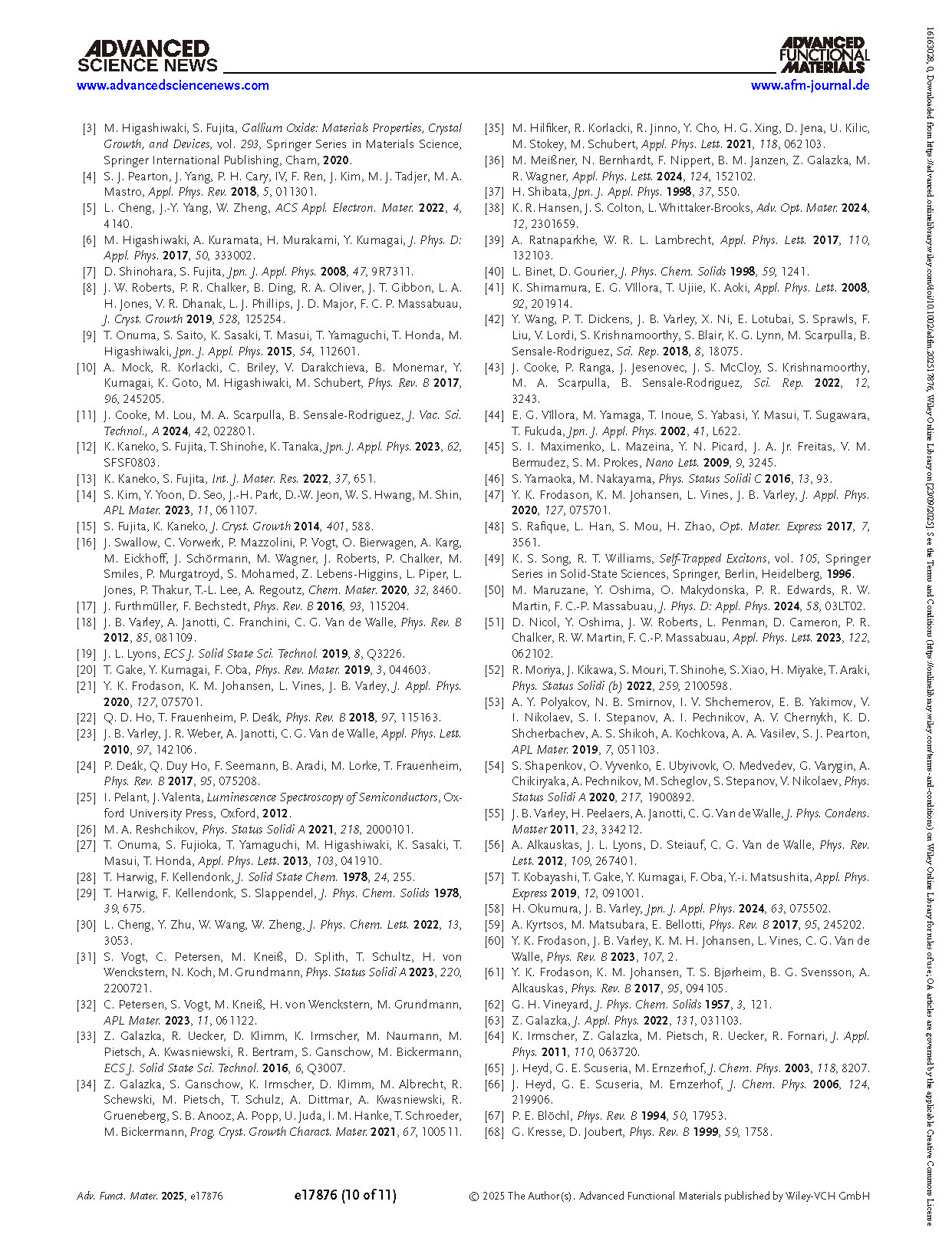
【International Papers】Self-Trapped Hole Migration and Defect-Mediated Thermal Quenching of Luminescence in α- and β-Ga₂O₃
日期:2025-10-16阅读:109
Researchers from the Leibniz-Institut im Forschungsverbund Berlin e.V. and University of Oslo have published a dissertation titled "Self-Trapped Hole Migration and Defect-Mediated Thermal Quenching of Luminescence in α- and β-Ga2O3" in Advanced Functional Materials.
Background
Ultrawide bandgap (UWBG) semiconductors offer compelling opportunities for the development of high-power and high-frequency solid-state electronic devices. Among these materials, the gallium oxide (Ga2O3) system, which comprises several polymorphs, stands out as one of the most promising UWBG candidates. Ga2O3 exhibits unique electronic and optical properties, including high breakdown electric fields (8 MV cm−1) and bandgaps in the deep UV region (exceeding 4.7 eV). These characteristics make Ga2O3 a strong competitor to established wide bandgap semiconductors such as silicon carbide (SiC) and gallium nitride (GaN). While its monoclinic β-phase is the only thermodynamically stable polymorph, increasing attention is being directed toward the metastable corundum α-phase. In particular, α-Ga2O3 offers an even larger bandgap (>5.3 eV) and higher crystal symmetry which results in a reduced anisotropy of physical properties. Such attributes could facilitate device fabrication and improve performance in practical applications. Moreover, α-Ga2O3 can be grown epitaxially on widely available substrates like sapphire (Al2O3), offering significant advantages in terms of cost and scalability for device manufacturing.
Abstract
Gallium oxide (Ga2O3) is a promising ultrawide bandgap semiconductor for next-generation power electronics and optoelectronic devices. Here, temperature-dependent and polarization-resolved photoluminescence excitation spectroscopy data, complemented by hybrid-functional first-principles calculations, are presented, and a microscopic model is derived that explains the interplay of hole migration, defect trapping, and carrier recombination at defects underlying thermal quenching phenomena in α- and β-Ga2O3. In α-Ga2O3, the UV emission is attributed to self-trapped holes, while the blue luminescence arises from defect-related processes, including gallium split vacancies and their defect complexes. Calculations reveal an energy barrier of 88 meV for self-trapped hole migration in α-Ga2O3, consistent with activation energies from temperature-dependent photoluminescence. This enables efficient trapping by defects, enhancing blue luminescence and quenching UV emission. In β-Ga2O3, a higher migration barrier of 0.36 eV reduces the defect trapping, allowing the UV self-trapped hole emission to remain intense, with blue luminescence emerging only at elevated temperatures. These results establish a direct link between self-trapped hole migration, defect trapping, and thermal quenching of emission in both phases. The insights advance the understanding of carrier dynamics in ultrawide bandgap oxides and may guide defect engineering for high-performance functional devices.
Conclusion
In this work, we have investigated the temperature-dependent luminescence mechanisms in high-quality α-Ga2O3 thin films and monoclinic β-Ga2O3 single crystals using polarization-dependent photoluminescence excitation spectroscopy, complemented by hybrid-functional first-principles calculations. Our results demonstrate that UV emission in both materials originates from self-trapped hole recombination. Blue emission is linked to defect-related processes, which include deep-level defects such as gallium split vacancies and their complexes. We also find that the excitation energy has a decisive influence on the emission behavior. When the excitation energy is above the bandgap, the UV emission is selectively enhanced. In contrast, sub-bandgap excitation preferentially activates blue luminescence through defect-assisted channels. This observation highlights how the optical response in Ga2O3 depends on both intrinsic and extrinsic states and demonstrates the potential for tuning emission properties by varying the excitation energy.
A key advance of this study is the identification of self-trapped hole migration as the microscopic mechanism responsible for the temperature-dependent luminescence behavior. Our combined experimental and theoretical approach shows that, in α-Ga2O3 thin films, the low migration barrier for self-trapped holes, calculated at 88 meV, enables efficient hopping and trapping at defects even at low temperatures. This process leads to rapid quenching of UV emission and enhances blue luminescence, thereby explaining the experimentally observed negative thermal quenching. In β-Ga2O3 single crystals, the migration barrier is higher, with a value of 0.36 eV. This results in greater thermal stability of self-trapped hole related emission and a delayed onset of defect-assisted recombination. These findings clarify how carrier localization, migration, and defect trapping interact and establish a direct link between microscopic polaron dynamics and the macroscopic optical properties of Ga2O3.
This improved understanding of excitation-dependent self-trapped hole dynamics and their impact on luminescence quenching advances the fundamental knowledge of recombination processes in ultrawide bandgap oxides. The insights gained from this work provide valuable guidance for defect engineering and the design of Ga2O3-based optoelectronic devices. Furthermore, these concepts are broadly relevant to other wide-bandgap oxide semiconductors.

Figure 1. Conventional unit cell of the trigonal corundum crystal structure of α-Ga2O3 showing the m-plane (orange), and local symmetry of the Ga-site (octahedral) and O-site (tetrahedral). Lattice parameters and bond lengths are indicated.

Figure 2.PL (left) and PLE (right) spectra at T = 5 K for α-Ga2O3 with polarization E∥c. The PL is shown for three different excitation energies: (i) 5.37 eV (magenta), (ii) 5.32 eV (blue) and (i) 5.17 eV (yellow), corresponding to (i) the maximum excitation of the UVL at 3.62 eV, (ii) the maximum excitation of the BL at 2.78 eV and (iii) the sub-bandgap excitation of the PL, respectively. UVL-PLE is obtained for emission energies of (3.62 ± 0.10) eV and BL-PLE for (2.78 ± 0.10) eV. A Stokes shift of 1.75 eV occurs between the maxima of the UVL emission and excitation maxima. The BL-PLE reveals efficient sub-bandgapexcitation for the BL band.
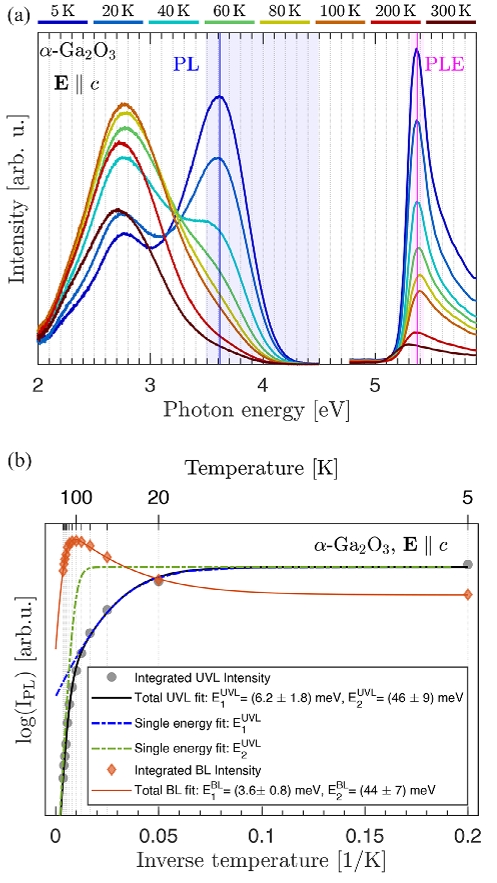
Figure 3.a) Temperature dependence of the PL and UVL-PLE spectra between 5 and 300 K. The shaded regions indicate the integration ranges used to generate the PL (magenta shading) at excitation energies of (5.37 ± 0.07) eV and the UVL-PLE (blue shading) for emission energies of (4.0 ± 0.5) eV. b) Temperature dependent integrated PL intensity and modeling of thermal quenching (TQ). Negative thermal queching (NTQ) of the BL and TQ of the UVL up to 100 K are described by activation energies E1BL and E1UVL, both of the order of 5 meV.
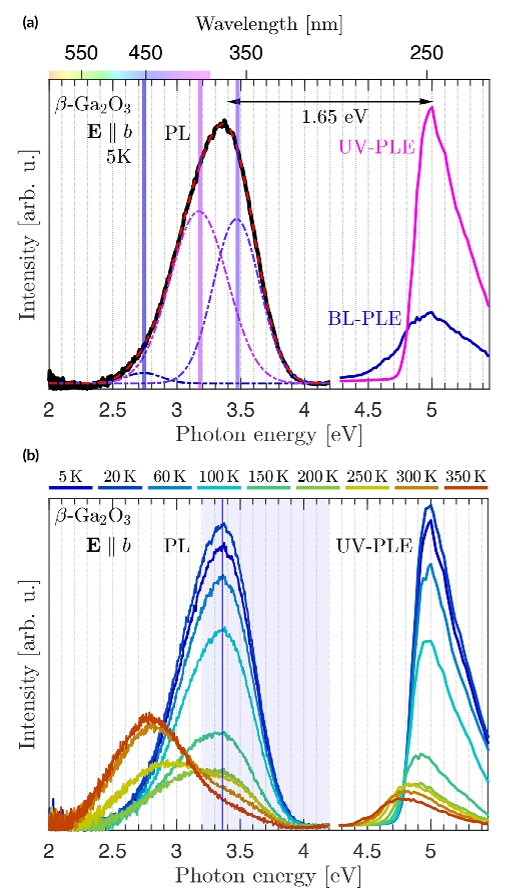
Figure 4.PL and PLE spectra for β-Ga2O3 with polarization parallel to the b-direction a) at 5 K and b) as a function of temperature. A broad PL is measured for excitation energies 5.0 ± 0.1 eV and is fitted with three Gaussian functions with peak positions of 2.74, 3.17, and 3.47 eV. The total fit is shown as a red dashed line and reproduces the PL very well. The UVL-PLE shows a peak at the bandgap energy of 5 eV, while the BL-PLE is slightly red-shifted with enhanced sub-bandgap signal. As the temperature rises, the BL band increases in intensity while both STH bands quench.
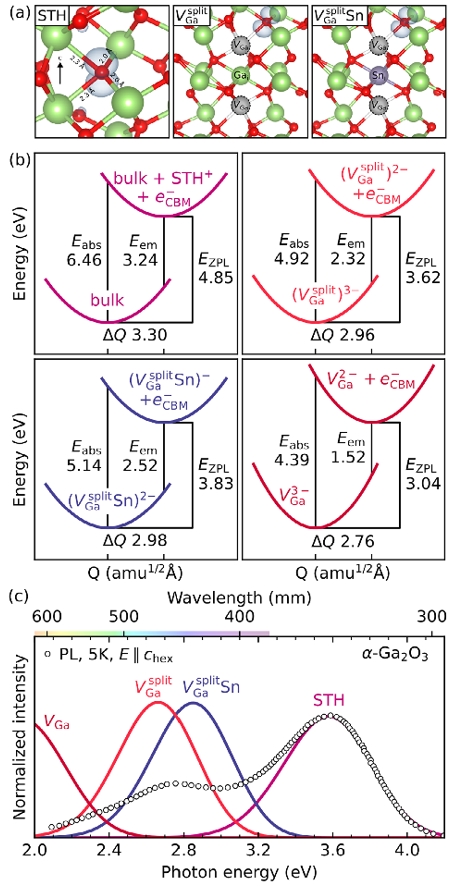
Figure 5.a) Relaxed structures of the self-trapped hole, split VisGa, VisGa Sn complex, and regular VGa. Holes are shown as blue isosurfaces at 5% of the maximum charge density. b) Configuration coordinate diagrams for optical transitions involving recombination of isolated and defect-bound (VisGa, VisGa Sn, VGa) hole polarons with free electrons at the CBM. c) Luminescence lines of the corresponding optical transitions. All theoretical curves have been systematically shifted up in energy by 0.27 eV to align the STH and UVL bands.

Figure 6.Migration barrier for a STH in α-Ga2O3 to hop between adjacent O sites. The structures show that the transition state corresponds to a configuration in which the hole is shared equally between the two O ions, as explained in the text.
DOI:
doi.org/10.1002/adfm.202517876
